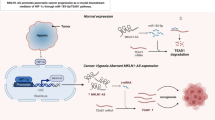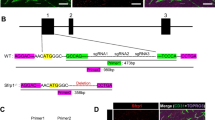Abstract
Tumstatin is the 28 kDa NC1 domain of the α3 chain of type IV collagen that inhibits pathological angiogenesis and suppresses endothelial cell proliferation and tumor growth. In the present paper, we expressed and purified recombinant human tumstatin protein and then prepared the anti-tumstatin polyclonal antibody. To investigate the expression of tumstatin in renal carcinoma, tumstatin protein was detected by western blotting using the prepared anti-tumstatin antibody and tumstatin mRNA levels were assayed by RT-PCR. The results showed that the expression of tumstatin gene was down-regulated in renal carcinoma tissues and cells. Our study suggests that as a novel endogenous angiogenesis inhibitor, tumstatin gene expression may be a marker for diagnosis, therapy and prognosis of renal carcinoma.



Similar content being viewed by others
References
Folkman J (1995) Angiogenesis in cancer, vascular, rheumatoid, and other disease. Nat Med 1:27–31
Folkman J, Shing Y (1992) Angiogenesis. J Biol Chem 267:10931–10934
Folkman J (1971) Tumor angiogenesis: therapeutic implications. N Engl J Med 285:1182–1186
O’Reilly MS, Boehm T, Shing Y, Fukai N, Vasios G, Lane WS, Flynn E, Birkhead JR, Olsen BR, Folkman J (1997) Endostatin: an endogenous inhibitor of angiogenesis and tumor growth. Cell 88:277–285
Hanahan D, Folkman J (1996) Patterns and emerging mechanisms of the angiogenic switch during tumorigenesis. Cell 86:353–364
Hamano Y, Kalluri R (2005) Tumstatin, the NC1 domain of alpha3 chain of type IV collagen, is an endogenous inhibitor of pathological angiogenesis and suppresses tumor growth. Biochem Biophys Res Commun 333:292–298
Carmeliet P, Jain RK (2000) Angiogenesis in cancer and other diseases. Nature 407:249–257
Linguraru MG, Yao J, Gautam R, Peterson J, Li Z, Linehan WM, Summers RM (2009) Renal tumor quantification and classification in contrast-enhanced abdominal CT. Pattern Recognit 42:1149–1161
Carmeliet P (2005) Angiogenesis in life, disease and medicine. Nature 438:932–936
Carmeliet P (2005) VEGF as a key mediator of angiogenesis in cancer. Oncology 69:4–10
Yu J, Ustach C, Kim HR (2003) Platelet-derived growth factor signaling and human cancer. J Biochem Mol Biol 36:49–59
Bochner BH, Cote RJ, Weidner N, Groshen S, Chen SC, Skinner DG, Nichols PW (1995) Angiogenesis in bladder cancer. Relationship between microvessel density and tumor prognosis. J Natl Cancer Inst 87:1603–1612
Giatromanolaki A, Koukourakis MI, Simopoulos C, Polychronidis A, Sivridis E (2003) Vascular endothelial growth factor (VEGF) expression in operable gallbladder carcinomas. Eur J Surgical Oncol 29:879–883
Jacobsen J, Rasmuson T, Grankvist K, Ljunberg B (2000) Vascular endothelial growth factor as prognostic factor in renal cell carcinoma. J Urol 163:343–347
Maeshima Y, Colorado PC, Torre A, Holthaus KA, Grunkemeyer JA, Ericksen MB, Hopfer H, Xiao Y, Stillman IE, Kalluri R (2000) Distinct antitumor properties of a type IV collagen domain derived from basement membrane. J Biol Chem 275:21340–21348
Maeshima Y, Colorado PC, Kalluri R (2000) Two RGD-independent alpha vbeta 3 integrin binding sites on tumstatin regulate distinct anti-tumor properties. J Biol Chem 275:23745–23750
Frojdman K, Pelliniemi LJ, Virtanen I (1998) Differential distribution of type IV collagen chains in the developing rat testis and ovary. Differentiation 63:125–130
Hamano Y, Zeisberg M, Sugimoto H, Lively JC, Maeshima Y, Yang C, Hynes RO, Werb Z, Sudhakar A, Kalluri R (2003) Physiological levels of tumstatin, a fragment of collagen IV alpha3 chain, are generated by MMP-9 proteolysis and suppress angiogenesis via alphaV beta3 integrin. Cancer Cell 3:589–601
Hudson BG, Reeders ST, Tryggvason K (1993) Type IV collagen: structure, gene organization, and role in human diseases. Molecular basis of Goodpasture and Alport syndromes and diffuse leiomyomatosis. J Biol Chem 268:26033–26036
Kahsai TZ, Enders GC, Gunwar S, Brunmark C, Wieslander J, Kalluri R, Zhou J, Noelken ME, Hudson BG (1997) Seminiferous tubule basement membrane. Composition and organization of type IV collagen chains, and the linkage of α3 (IV) and α5 (IV) chains. J Biol Chem 272:17023–17032
Maeshima Y, Yerramalla UL, Dhanabal M, Holthaus KA, Barbashov S, Kharbanda S, Reimer C, Manfredi M, Dickerson WM, Kalluri R (2001) Extracellular Matrix-derived peptide binds to αvß3 integrin and inhibits angiogenesis. J Biol Chem 276:31959–31968
Sudhakar A, Sugimoto H, Yang C, Lively JC, Zeisberg M, Kalluri R (2003) Human tumstatin and human endostatin exhibit distinct antiangiogenic activities mediated by αvß3 and α5ß1 integrins. Proc Natl Acad Sci USA 100:4766–4771
Maeshima Y, Manfredi M, Reimer C, Holthaus KA, Hopfer H, Chandamuri BR, Kharbanda S, Kalluri R (2001) Identification of the anti-angiogenic site within vascular basement membrane derived tumstatin. J Biol Chem 276:15240–15248
Maeshima Y, Sudhakar A, Lively JC, Ueki K, Kharbanda S, Kahn CR, Sonenberg N, EHynes RO, Kalluri R (2002) Tumstatin, an endothelial cell-specific inhibitor of protein synthesis. Science 295:140–143
Pasco S, Ramont L, Venteo L, Pluot M, Maquart FX, Monboisse JC (2004) In vivo overexpression of tumstatin domains by tumor cells inhibits their invasive properties in a mouse melanoma model. Exp Cell Res 301:251–265
Chung IS, Son YI, Ko YJ, Baek CH, Cho JK, Jeong HS (2008) Peritumor injections of purified tumstatin delay tumor growth and lymphatic metastasis in an orthotopic oral squamous cell carcinoma model. Oral Oncology 44:1118–1126
Gu Q, Zhang T, Luo J, Wang F (2006) Expression, purification and bioactivity of human tumstatin from Escherichia coli. Protein Expr Purif 47:461–466
Acknowledgments
We would like to thank Dr. Jifeng Bian for donation of pTriEx-4 plasmid and Dr. Yuzhu Xiang for collection of renal carcinoma and adjacent tissues. This work was supported by the Foundation of the Department of Science and Technology of Shandong Province (No: 2008GG30002030).
Author information
Authors and Affiliations
Corresponding author
Rights and permissions
About this article
Cite this article
Xu, Cx., Liu, Xx., Hou, Gs. et al. The expression of tumstatin is down-regulated in renal carcinoma. Mol Biol Rep 37, 2273–2277 (2010). https://doi.org/10.1007/s11033-009-9718-9
Received:
Accepted:
Published:
Issue Date:
DOI: https://doi.org/10.1007/s11033-009-9718-9




